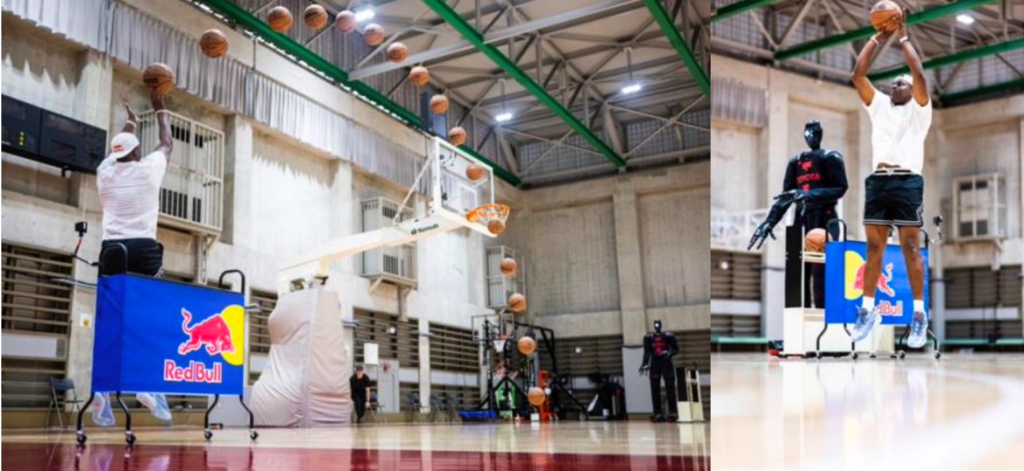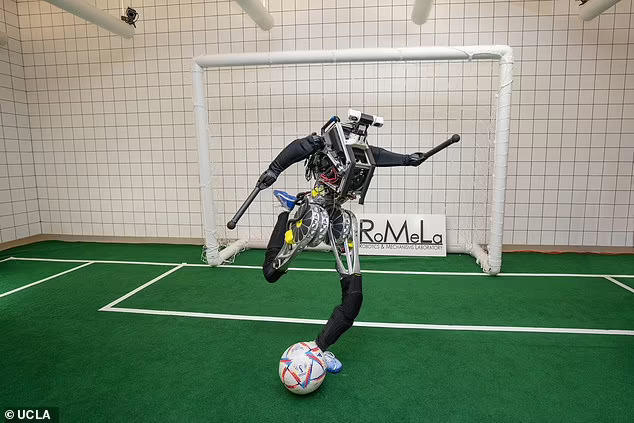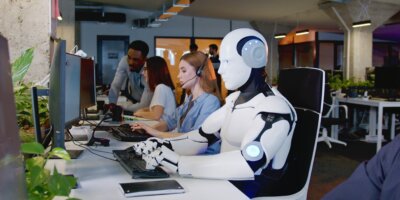
A unique collaboration between Lethal Shooter and Cue6. (Source – Red Bull)
Robots as athletes: Can AI beat renowned NBA shooting coach?
|
Getting your Trinity Audio player ready... |
- NBA coach Chris Matthews and AI robot CUE6 draw in a unique basketball challenge.
- Toyota’s basketball robot CUE6 is grabbing high-profile attention.
- Artemis, a robot, potentially outperforms human athletes.
Looking back at the pivotal moment when IBM’s Deep Blue, an AI system, challenged human intelligence in a high-profile chess event in 1996, it’s clear that the evolution of AI systems, particularly robots, has been exponential in both capability and intelligence.
By 2023, AI advancements continue to fascinate. In a thrilling basketball duel, NBA shooting coach Chris “Lethal Shooter” Matthews faced an exciting challenge against CUE6, a Guinness World Record-holding humanoid robot. This riveting event was later shared on Matthews’ YouTube channel.
The competition between Matthews and CUE6 encompassed three tasks: shooting from official NBA 3-point corners, shooting from the top of the key to halfcourt, and shooting into a 13-inch rim instead of the standard 18-inch one. The match ended in a draw, showcasing remarkable shooting skills from both contestants and promoting collaborative efforts to enhance the robot’s capabilities further.
The building blocks of a basketball robot
The AI-powered robot CUE was developed by the Toyota Engineering Society (TES) in 2017. The robot quickly gained recognition by setting a Guinness World Record for the most consecutive basketball free throws made by a humanoid robot, totaling 2,020 successful shots.
Guided by development team lead Tomohiro Nomi, the Toyota team started their journey with basic materials like Lego blocks to construct early robot models. They looked to existing robots for inspiration and experimented with simple prototypes capable of basic movements like swinging.
The development process began with the creation of a basic Lego model, progressed to a robot with a single arm, and ultimately culminated in a complete robot. This methodology of learning by imitation played a crucial role in their approach.
Equipped with advanced sensors and algorithms, CUE6 can analyze a player’s shooting mechanics in real-time, identifying areas for improvement and providing instant feedback. The robot’s precision and consistency quickly attracted the attention of high-profile figures, including Matthews.
Nomi confessed that the initial model fell short in terms of aesthetic appeal. Challenges varied with each model, but the primary difficulty initially was stepping into uncharted territory. The team initially resorted to purchasing external components such as motors and internal mechanisms.
However, the endorsement from Akio Toyoda, the president at the time, who found the CUE concept intriguing, led to a shift in perspective. This concept was encouraged as a professional endeavor, prompting the team to manufacture their internal components. The journey to create fully functional robots introduced various challenges involving hardware, electrical parts, and software.
Insights into robot limitations and future efforts
Each iteration brought new technical challenges. Deadlines for each model were typically tight, often resulting in completion just before or even on the deadline day. Yet, they always managed to finish in the nick of time.
The robot utilizes internal mapping technology similar to AGVs and self-driving cars, enabling it to move around and continuously ascertain its position relative to the map. Motor movement and battery cells are repurposed from racing car batteries, and other automotive parts have also been ingeniously repurposed. The team sought assistance from individuals involved in car manufacturing and equipment development for parts processing. A considerable amount of knowledge acquired from car manufacturing was integrated throughout the technological development process.

NBA shooting coach goes head-to-head against robot in basketball challenge. (Source: Red Bull)
Matthews, known for training star athletes like Anthony Davis, Candace Parker, and even Drake, recalls his first encounter with CUE, “About two and a half years ago, I saw CUE on TV and said, ‘This robot is remarkable. I would love to meet it. I shared the idea with Red Bull and they made it happen. We headed to Tokyo and walking into the gym, I couldn’t help but feel overwhelmed. CUE is not a regular robot. It never misses, and if it does, it self-calibrates for the next shot. Shout out to Toyota and the engineers behind it.”
Nomi admits CUE’s main shortcoming is its inflexibility. “While it possesses impressive capabilities, there are still numerous tasks it cannot perform. To address this, we relied on Lethal Shooter to compensate for CUE’s limitations, gaining insights and techniques directly from experienced individuals serves as a valuable shortcut to improve overall performance of the robot,” Nomi explained.
AI robots vs. humans in game arenas
The historical confrontation between Deep Blue and world chess champion Garry Kasparov in 1996 still holds significance. Deep Blue’s victory in the first game was groundbreaking, marking the first time an AI system had defeated a reigning world champion under standard tournament time controls. Kasparov triumphed in the match by winning three games and drawing two.
Fast-forward to 1997, a rematch between Deep Blue and Kasparov resulted in AI’s victory. This event marked a pivotal turn, as an AI system defeated a world chess champion in a match format for the first time.
Recently, Artemis, a 4ft 8in humanoid football-playing robot, is set to participate in an international tournament. Experts tout her abilities as surpassing those of Lionel Messi. Artemis, developed by researchers from UCLA, is among only three robots worldwide capable of running. She can also walk and jump, and her name – an anagram for ‘A Robot That Exceeds Messi In Soccer’ – hints at her extraordinary skills. During tests, Artemis achieved a record-breaking walking speed of 2.1 m/s. Since then, researchers have been preparing her for the competition by taking her for walks around the university campus.

A robot that is said to “exceed Lionel Messi” in football. (Source – Daily Mail)
However, questions remain: should we be apprehensive about the rising prominence of machines? Could they potentially replace athletes or even humans in various capacities? To answer this, comparisons between humans and robots need to be drawn. A study by the University of Florida showed that humans’ brains work significantly harder when competing against robots in sports. The researchers analyzed hours of table tennis matches featuring humans competing against robots and other humans.
Participants wore electrode caps to monitor their brain activity during the games. The study revealed that when humans competed against each other, their brains worked in harmony, as if ‘speaking the same language’. However, when humans played against a ball-serving machine, their brains exhibited desynchronization – neurons were not aligned similarly.
Daniel Ferris, a professor of biomedical engineering at the University of Florida, likened this phenomenon to a crowd of 100,000 people in a football stadium. He pointed out that when the crowd cheers, it’s like brain synchronization, indicating a relaxed state. On the other hand, when the crowd engages in individual conversations, it’s akin to desynchronization – suggesting the brain is performing numerous calculations rather than being in a relaxed state.
READ MORE
- Safer Automation: How Sophic and Firmus Succeeded in Malaysia with MDEC’s Support
- Privilege granted, not gained: Intelligent authorization for enhanced infrastructure productivity
- Low-Code produces the Proof-of-Possibilities
- New Wearables Enable Staff to Work Faster and Safer
- Experts weigh in on Oracle’s departure from adland


